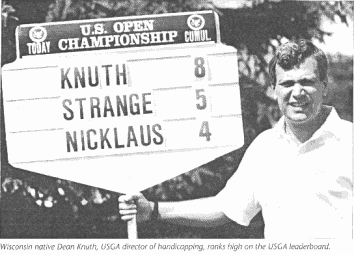|
Wisconsin Native Dean Knuth Designed the Slope System

Wisconsin native Dean Knuth designed the Slope System and watched it lead to a rewarding career with the USGA
By Jerry Poling
Wisconsin Golf, December 1991
By now most golfers in Wisconsin know the lay of the Slope System. They should because Slope has been a fact of golf life here for eight years, longer than in all but one other state. Thus it's no big news that on March 31 Slope became the official United States Golf Association handicapping method across the land. Slope is here to stay. What state golfers probably don't realize is that the roots of the Slope System, now on its way to worldwide acceptance, go much deeper in Wisconsin. Slope was invented by a Wisconsin native, Dean Knuth.
Knuth, 44 (in 1991), who grew up playing public courses in the Eau Claire area, was in Naval post-graduate school back in 1975 in Monterey, Calif. He had a class assignment that involved finding a problem, collecting data and formulating a solution.
"Being an avid golfer, I contacted the Northern California Golf Association and said, 'Do you have any problems in golf?' They said, 'Yeah, the USGA rating system doesn't work. It evaluates courses purely on length and not on difficulty,'" Knuth recalls.
So Knuth, out of duty to his country, went to work. He experienced the problem firsthand one day when he played the famed Pebble Beach Golf Links and realized the unlikelihood of playing to his handicap on such a tough course.
The seeds for Slope were planted.
Here's how it grew to be: With Slope, golfers' handicaps vary with the difficulty of the courses they play. Courses nationwide have been Slope-rated to take into account many factors, of which length is only one. When golfers play away from their home courses, they check Slope conversion tables to get their new handicaps.
Knuth must have done A-plus work because in 1977 the USGA sent him a letter while he was aboard an aircraft carrier in the Mediterranean Sea. They had heard of hi,. hypothesis and "loved it," Knuth says.
Four years later, in 1981, after he left the Navy and took a job with Rockwell International, the USGA gave him another call. This time they wanted him to come to work in a made-for-Dean Knuth � job � director of handicapping. His first task: implement the Slope System.
Although once-promising Navy and computer systems careers were left in the wake, Knuth hasn't regretted his change of course. He has seen his Slope gain acceptance, albeit over a 10-year period.
Like the Slope System itself, Knuth's career at the USGA has blossomed. In addition to his job as director of handicapping, Knuth heads the burgeoning Golfer Handicapping Information Network (GHIN) and is administrative director of the important Green Section Committee. In 1988-89, he was director of the Regional Affairs Committee.
When the USGA holds its major tournaments, such as the U.S. Open held at Hazeltine in Chaska, Minn., last June, Knuth is on the scene coordinating hundreds of volunteers for the computerized scoreboard and leaderboard operation. He works out of Golf House, the USGA's head-qaurters in Far Hills, N.J. There he oversees more than one- 'rd of the full-time staff of 140.

In an article in the June edition of Golf Digest, Knuth was cited as one of 14 "key players" in the USGA.
"For a golfer, I must have one of the best jobs in the country," says Knuth. "I never regretted leaving the Navy."
The success of the Slope System has had much to do with Knuth's success at the USGA.
Although there have been problems with golfers under- standing and making use of it, no one has doubted Slope's effectiveness. Now it's common for golfers to cite the Slope rating when they talk about a course's difficulty. When golfers refer to their handicap these days, it's not just a 14 but a 146, thanks to Slope's handicap-index.
Slope, the newest word in golf talk, has made handicaps portable and many golfers happy.
"Once people know that they get more strokes at a difficult course � that's the whole reason � they embrace it," Knuth says.
"The biggest problem is education. How do you explain to a golfer how it works'?" Knuth says. "We're still faced with millions of golfers who don't know."
Getting golfers to embrace it hasn't been easy. Getting golf officials to embrace it has.
The first state to adopt the Slope System was Colorado in 1983. Wisconsin and five other states followed in 1984. In 1985, 20 more states joined in. As of March 31, it was mandatory in every state, although some, like Texas, have lagged in getting their courses Slope rated.
The system has "worked beautifully," according to Knuth. State golf association directors from around the country, including Gene Haas of the Wisconsin State Golf Association, have agreed.
In the near future, Slope will be adopted in Canada, Knuth says. He also went to the British Open in July to expose the Slope System to the Europeans, who are expected to adopt it.
"We had a meeting of representatives of the World Handicap Council, which is being formed, at the British Open. Our goal in 1994 is to recommend the Slope System worldwide. It's moving much faster than I thought," Knuth says.
When Knuth traveled to Argentina to introduce Slope there, he was befuddled when he heard the Argentines calling him "Popa de Slopa." Knuth asked an interpreter what it meant, and his moniker was born: "Pope of Slope," which is how he is known around the USGA.
Knuth has made believers out of many golfer s, especially the average ones. Although he has master's degrees in computer systems technology and math, Knuth claims to be among the large group of "average golfers," with a very respectable handicap-index of 9.7.
It is with pride that he reports that he won the USGA staff golf tournament in October with a 77, including 35 on the front nine. He owes his triumph to a long putter and to the fact that his boss, USGA Executive Director David Fay (handicap index 7.0), was absent.
When he graduated from Eau Claire Memorial High School in 1965, Knuth was on the baseball team, not the golf team. However, he still played often on courses like Hallie Golf Club, Hillcrest Country Club and Osseo Golf Club.
After a perfect 800 score on the math portion of the Scholastic Aptitude Test (SAT), Knuth spent one year at the University of Wisconsin-Eau Claire before going to the U.S. Naval Academy in Annapolis, Md. He spent 11 years in the Navy, including 1972 in Vietnam, and rose to the rank of lieutenant commander.
Knuth doesn't travel as much now as when he was in the Navy, but he still gets plenty of frequent-flier miles going to tournaments and working with state golf associations. Implementing the Slope involved traveling to every state to train course-raters; more than 11,000 courses have been Slope rated.
"I've seen them all, "he says, refer- ring to the top U.S. courses. He is one of the panelists who regularly helps Golf Digest pick its top 100 U.S. courses.
He thinks that Wisconsin is one of the best places to play golf because of its proliferation of mom-and-pop courses. Knuth dislikes the national trend of building big-budget, high- profile courses.
"In Wisconsin you see a lot more low-end courses and the lowest greens fees I've seen of any state. I think that's great. Anybody can go play and have fun," he says.
"Sometimes golf has this exclusionary image that it's a game for the upper class, but that's not true in Wisconsin. Wisconsin has almost all public courses. The accessibility is tremendous. At courses near the USGA office, people stay in campers on Friday nights, the greens fees are $30 and the golf is not much different than the courses in Wisconsin."
Although outstanding courses like BlackwolfRun, Geneva National or SentryWorld are great to play, Knuth doesn't think they do much for the game.
"They're interesting to play once, but not where you play everyday. On a daily basis I'd rather play Osseo municipal for six bucks," Knuth says. "This attitude has become pervasive that you've got to build Kiawah Island every time in order to get any attention. There's not nearly enough emphasis on building low-budget courses. You get so much more bang for the buck if you build a lot of cheaper golf courses that can support a lot of people."
Knuth's involvement in the Green Section keeps him directly involved in course construction.
The Green Section Committee oversees development of new grasses through a branch known as the Turfgrass Research Committee, formed in 1982. Grants totaling $750,000 will be given to 15 universities this year to develop grass that needs less water and fewer chemicals to remain playable.
"There will be one on the market in three to four years that will need half the water and half the pesticides. There's the Sahara, which needs only one inch of water a year � that's on the market now," Knuth says.
Few people know, Knuth says, that most kinds of grass growing in the U.S. today were developed through the USGA.
Knuth predicts that water usage soon will become a "major issue in every state," thus the importance of new grasses. The Green Section Committee also helps courses maintain their grass through Turf Advisory Service. This year, the TAS offered a bargain. One of the USGA's l4 field agronomists would visit a course for a half-day at $700 and a full day for $1,200, although the USGA actually loses money on that price.
Much of Knuth's work involves determining the environmental impact of building and maintaining golf courses. That's "the No. 1 issue with the USGA presently," he says.
The USGA recently began the Audubon/USGA Sanctuary program, in which courses set aside their undeveloped land for wildlife use. Already 200 courses have joined, Knuth says. That should quiet some of the legislators and environmental groups that want more restrictions on the vast amounts of pesticides used to make courses green and weed-free.
"We have $3 million budgeted to study ways for the environment and golf to live together. We are the leader on the environment and golf," Knuth says. "We have to make sure golf exists in the long term."
In 1990 the USGA's income was $14.5 million ( including $11 million from the U.S. Open) and its expenses were $6.88 million. The handicapping services, including GHIN, cost the USGA $460,000, Turfgrass Research $570,000 and Green Section $890,000.
GHIN is a l0-year old service. A total of 53 golf associations (not including Wisconsin) pay the USGA to compute their members' handicaps. That amounts to more than 5,200 courses and l.2 million golfers. GHIN has grown so rapidly that soon it will be in a 15,000-square-foot facility separate from Golf House in New Jersey.
But while Knuth's duties with the USGA have been broadened over the years, it is still Slope that gives him his identity. "The Pope of Handicapping" just doesn't have the same ring.
|




